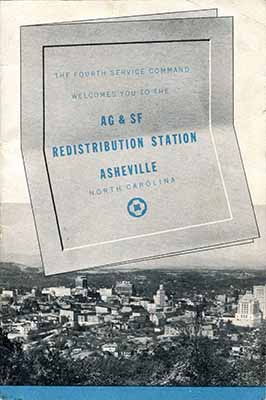U.S. Army Redistribution Stations in World War II: Asheville, North Carolina

In Asheville, North Carolina, the U.S. federal government rented three of Asheville’s main hotels and the basement of the Asheville City Auditorium to operate as the U.S. Army Fourth Service Command’s Army Redistribution Station (ARS). Officially, it was known as the Army Ground and Service Forces (AG & SF) Redistribution Station, Asheville, North Carolina. The housing facilities that were a part of the Redistribution Center included: the Battery Park Hotel on Haywood Street; the George Vanderbilt Hotel; and the Asheville-Biltmore Hotel. When Army soldiers came to Asheville to be part of the redistribution process, they would go to the lower level of the Asheville Auditorium.
The Asheville Redistribution Center featured a six-part program.
Part I included the Education and Information Division, which gave soldiers a seven-hour program consisting of talks and movies on the progress of World War II, the GI Bill of Rights, current events, and the operations of the U.S. military in the various theaters of the war.
Part II included a detailed physical examination held in the Redistribution Center’s Medical Department on the ground floor of the Battery Park Hotel.
Part III consisted of soldiers taking a new Army General Classification Test, which was administered in the lower level of the Auditorium.
Part IV included the updating of a soldier’s records and classification following the classification test, part of which involved a meeting of a program administrator with the soldier to review the corrections to a soldier’s records. Part V was a classification and assignment interview, the purpose of which was to “adjust your own ability to the ever changing needs of the service.”
The last part—Part VI—involved intelligence officers interviewing the soldier in order that the soldier’s military experience with equipment, weapons, enemy tactics, and other military-related information would be added to the soldier’s personnel file.
The Redistribution Center was designed to involve only the first few days of a soldier’s arrival in Asheville, after which the soldier was encouraged to rest and take advantage of the recreational opportunities offered through the Army program. The Redistribution Center’s program had a sports program (including water sports); social activities like dance parties and movie showings; and sightseeing at such locations as Chimney Rock. The program’s goal was to reconnect soldiers who had been in combat zones or in combat mode with civilian life and stateside activities. Rest was stressed in the program during a time prior to the recognition of such a thing as Post-Traumatic Stress Disorder (PTSD), which back during WWII was referred to as “combat fatigue,” “battle neurosis,” or “combat stress.”
Image Credit:
U.S. Army Asheville Redistribution Station Booklet, WWII 27, WWII Papers, Military Collection, State Archives of North Carolina, Raleigh, N.C.
27 June 2016 | Peek, Matthew M.